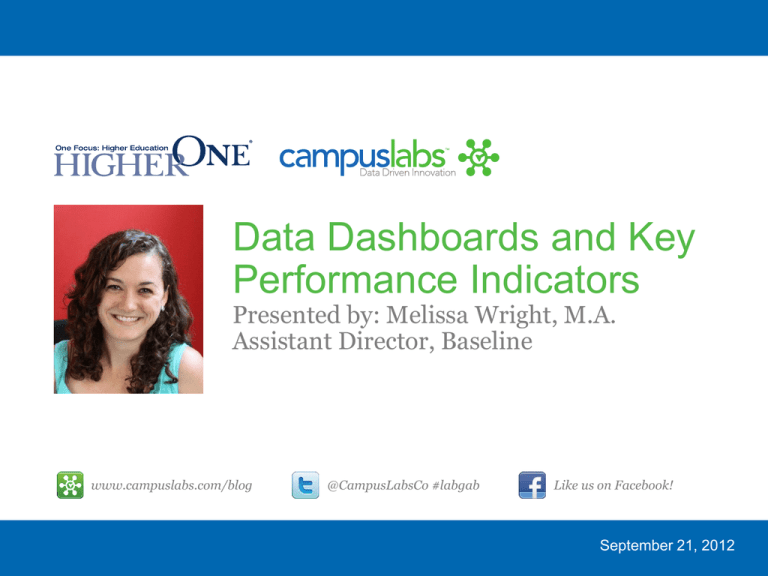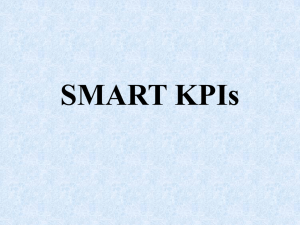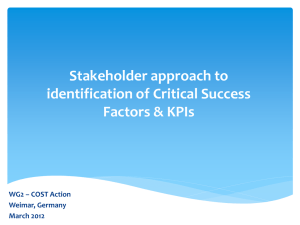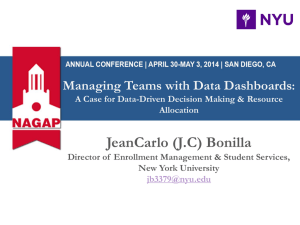Key Performance Indicator (KPI) - University of Alaska Anchorage
advertisement

Data Dashboards and Key Performance Indicators Presented by: Melissa Wright, M.A. Assistant Director, Baseline www.campuslabs.com/blog @CampusLabsCo #labgab Like us on Facebook! September 21, 2012 What are key performance indicators? performance indicator metrics dashboard balanced scorecard report card success factors Based in business • Balanced Scorecard – grounded in strategic initiatives • Communicates priorities to constituents (internally & externally) • Four perspectives o o o o Financial/resource allocation Customer/operational & program outcomes Internal Business Process/key stats Learning and Growth/learning outcomes Steps to implementation Articulate Operationalize Create Share Steps to implementation Articulate Operationalize Create Share Starting points • Existing KPIs on your campus • Mission and vision • Strategic plan • Learning outcomes frameworks (e.g., CAS, AAC&U) • Numbers you are already using • Questions you are already asking Example performance indicators Graduation Rate GPAs Retention Rates Annual Giving Satisfaction Campus Climate Student Awareness Campus Safety Student Participation Class Size Outcome Measures Student Engagement Number of courses Credit Hour Production Contact Hour Housing Occupancy Rates Student Conduct Incidents Student: Faculty Ratio Programs Offered Service Hours Direction of KPI development University Division Department Program Institutional Dashboards Institutional Dashboard Examples: - Mean SAT score - Research Funding - 4 or 6 year Graduation Rate - Doctorates Awarded - Undergraduate Enrollment - Graduate Enrollment - Alumni Giving - Financial Aid Awarded - Scholarships Awarded Divisional Dashboards • Provide information on the direction of the organization • May not be directly actionable for departments • Primarily shared “up” or “out” • Examples: – – – – Overall student satisfaction Retention rates Annual giving Participation rates Divisional Dashboard example Division of Enrollment Management and Student Development: - % overall student satisfaction rates (by semester) - % student engagement rates (by level of connectedness) - % student involvement rates (by semester) - Learning outcome domain rates (by type of learning environment) - % student development rates (by subject area) Divisional Dashboard example Division of Academic Affairs: - Align with academic strategic plan - Use NSSE measures for student engagement as a structure for goals: – – – – – level of academic challenge active and collaborative learning student-faculty interaction enriching educational experiences supportive campus environment - Example: Buffalo State’s score for the “active and collaborative learning” NSSE benchmark area will rise from 49.7 to at least 55.4, or to a score that earns Buffalo State a place in the upper 50 percent of NSSE institutions. Department Dashboard • Focus on the aspects of the department that are critical • Measured frequently and more actionable • Measures are understood by staff members • Have significant and positive impact on daily operations • Examples: – Knowledge of policies/procedures – Perceptions – Outcome measures Departmental dashboard example Parent Program: - # contact via email (by year) - # Parent Council Membership (by year and class) - % in-state vs. out-of-state residence - % satisfied with email contact - % satisfied with accessibility of Parent Liaison - % parents who considered themselves “involved” Goals and targets In order to indicate progress or success, a goal or target is needed o External (e.g., determined by board of trustees) o Internal (e.g., director determined goals for department) o Objectively stated (e.g., retention goal of 89%) o Subjectively stated (e.g., learning outcome mean of 4) Considerations Is the development of KPIs internally driven or externally required? Who will be USING the KPIs? With whom will you be SHARING the KPIs? Are others on your campus also developing KPIs? Is there an existing committee that can lead the KPI development process? Keep it simple At core, the performance indicator is simple and informative. KEY is the important word Steps to implementation Articulate Operationalize Create Share Data collection methods Keep in mind: KPIs are quantitative/numbers and can come from: • • • • Campus or student record systems Tracking Surveys Rubrics Data collection: Existing campus systems Data collection: Tracking • Student attendance • Number of programs • Student organization involvement • Student use of departmental services • Community service hours Data collection: surveys Data collection: Rubrics Single Source Multiple Sources 80% satisfaction 80% satisfaction 70% satisfaction 90% satisfaction 80% satisfaction Single question on a single survey Single question on multiple surveys Multiple questions on single/multiple surveys Ways to represent data Count Percentage Mean Use terms consistently Create data audits and/or data dictionaries Define terms: – – – “Student” Class year Terms/time periods Effect on the assessment process • Incorporate KPI into planning or project proposals • Develop a standard set of scales and question formats • Consider response rate requirements for inclusion in KPIs • Create a data dictionary Steps to implementation Articulate Operationalize Create Share How Campus Labs Can Help • • Collect event attendance and participation numbers Track exposure to outcome to link to learning/growth based performance indicators • Embed performance indicators within your planning and reporting process Show concrete metrics that track improvement towards your larger goals and outcomes • • • • Collect survey and rubric data for performance indicators Create a variety of performance indicators Work with your assessment consultant to identify best practices for your institution or division QUESTIONS? Melissa Wright, M.A. Assistant Director Campus Labs Team mwright@campuslabs.com 716.270.0000











